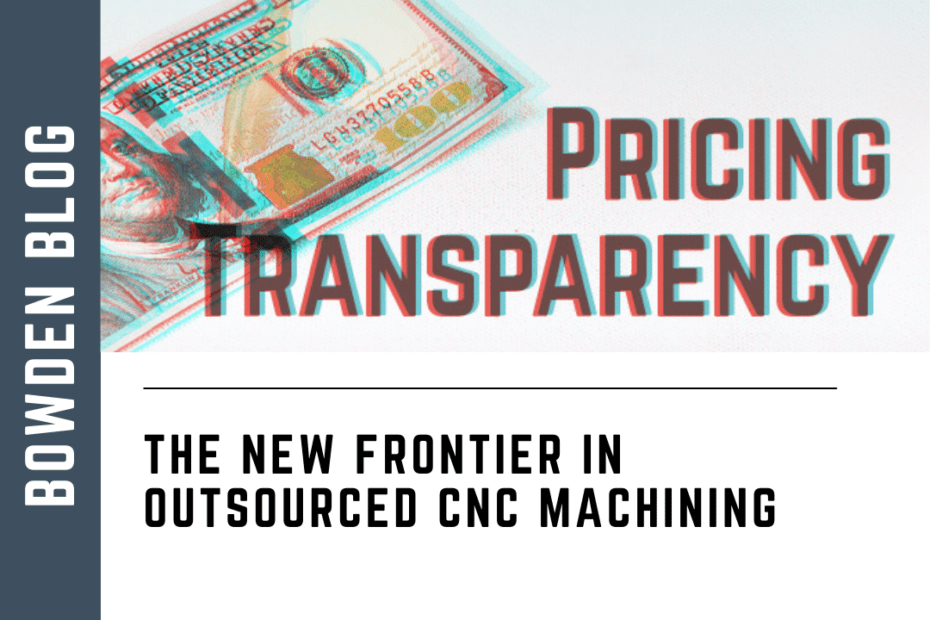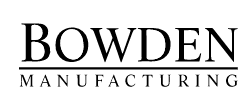Question: What’s the biggest reason machining vendors don’t feel like an in-house shop?
Answer: No pricing transparency.
With inflation making things a little crazy (does anyone believe it’s only 8%?!?), it can be frustrating to have all of the pricing from your vendors going up with very little explanation. Yes, you know things are getting more expensive, but it doesn’t always seem like you’re getting much justification.
Raw material prices have certainly increased in recent months, but do you expect that you’ll get prices to return to “normal” when inflation subsides? Most people don’t.
At Bowden, we want to be the next best thing to an in-house CNC shop.
The biggest thing that’s typically missing when the shop isn’t in-house….pricing transparency.
Well, that ends now.
We’re willing to share data so that we can help optimize our process and help provide the overall best value.

Here’s the three big pillars of our Pricing Transparency model:
- Standardized Shop Rates
- Standardized Material & Outside Process Mark-Up
- Outcome Reviews between Runs
1. Standardized Shop Rates
Most shops have a “Shop Rate” that is used for quoting and costing purposes.
Sometimes they’re willing to share those rates, but often they are not.
We have developed our Shop Rates over the years and use a combination of two factors: the type of machine for each operation and the needed skill level of the operator.
Typical Shop Rates for an AS9100 operation range from $60/hour to $125/hour, depending on the type of equipment and complexity of the work.
Our Shop Rates range from $60/hour to $100/hour.
As we dig in on a new project, we lay out the manufacturing process plan so that we can identify both the best method and appropriate skill level required to make good parts.
Each operation has its own Shop Rate for setup and production.
By getting that granular in our estimates, we can see opportunities for cost reduction or improvement as we communicate back to the prospective Customer.
For example:
- Our largest and most expensive machines are our Horizontal Machining Centers. The Shop Rate for time on a Horizontal varies between $80/hour – $100/hour depending on the skill level required for the operation.
- Our smallest and least expensive machines are our Mini Mills. The Shop Rate for time on the Mini Mills ranges from $60/hour – $80/hour depending on the skill level required for the operation.
- Establishing the criteria for our Shop Rates moves things past the typical shroud of secrecy between pricing, cycle times, and ultimate cost.
2. Standardized Raw Material & Outside Process Mark-Up’s
Most shops mark-up the raw materials that they purchase to run their jobs.
The typical mark-up ranges between 25%-50%.
We mark-up our raw material 38%.
Why do manufacturers mark-up raw materials?
While it may seem like raw materials should just be a pass-through cost, the reality is that a lot of time and effort goes into providing them. In fact, when you take into account the quoting, ordering, incoming inspection, certification verification, holding, and transportation of the raw material, and possible charges to scrap any of the unused or discarded raw material, there are significant costs incurred.
Our willingness to share material pricing with our Customers is an important opportunity for them to have confidence in us and separate the material cost fluctuations from other price factors. We appreciate it because it helps us adjust in these inflationary times, without trying to guess what the next raw material quote will look like.
Outside processes (i.e. heat treating, anodizing, painting, etc.) fall into a similar category for us.
We don’t perform those processes in-house, so we are merely marking them up to cover our costs, in a similar way that we do for raw materials.
From quoting and ordering through incoming inspection and certifications, there are costs associated with using outside vendors to provide a more turn-key option for our Customers.
Seeing actual costs from both the raw material and the outside processes provides unusual transparency for our Customers and allows for corrections in both directions as inflation comes and goes.
3. Outcome Reviews Between Runs
It’s typical in the manufacturing world that once you set up a vendor, you put their pricing in your system and it rolls on for years at a time.
As long as there aren’t any major hurdles for either side, the inertia of business and life keeps things going down a consistent path.
Unfortunately, the inertia of business doesn’t always provide optimal solutions!
Sticking with the same vendors and prices year in and year out is certainly the path of least resistance.
We believe that reviewing jobs after they’ve run provides an opportunity to make adjustments for three key reasons:
- The job ran well – If the job ran well, we have an opportunity to review the data and help our Customer be more competitive in their marketplace. Certainly, we want to have the incentive to both improve the process and allow we can get some benefit for improving the value we provide, but mostly we know that our returns will come from the growth of our Customer’s business. This is when it really feels like an in-house shop…when we can take advantage of it when things go well.
- The job didn’t run well – If the job didn’t run well, we have the opportunity to review the data with the Customer to see how we might improve for the following time. Working to at least hold the pricing based on the actual cycle times, based on adjustments, and potential process improvements is an important opportunity. We certainly don’t like to have to raise our prices, but it feels like an in-house shop when we can review the data with our Customer to figure out better ways to accomplish the goal without increasing cost.
- There are opportunities for improvement – Once we’ve run a job, we know a lot more about the part. Seeing first-hand the complexities and challenges of any job can prompt ideas on how to make it better. By programming with an expectation that we’ll review the job after it’s run, we’re setting things up to improve the process as well as the pricing going forward. In many instances, forcing ourselves to have these sessions with our Customer actually makes it feel better than an in-house shop…..it’s rare that these discussions happen with regularity inside manufacturing organizations.
Transparency – The New Frontier in Outsourced CNC Machining
Outsourcing your CNC production machining to an AS9100 shop doesn’t have to be an arms-length proposition. We believe that partnering with our Customers so that we feel like an in-house shop is the most productive way to engage in the marketplace.
In these inflationary times, that transparency is even more important as price increases are widespread but typically come with very little justification. There’s also very little expectation that when the market returns to normal, that the prices will come back down appropriately.
Let Us Show You What Pricing Transparency Looks Like
If you want to explore a conversation to see how adding transparency to your Customer-Vendor interaction might give you some peace of mind, please reach out to us today.

